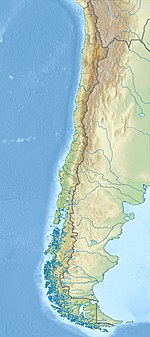Cura-Mallín Group
| Cura-Mallín Group | |
|---|---|
Bío Bío Regions Neuquén Province | |
| Country | Chile Argentina |
| Type section | |
| Named for | Mallín |
Cura-Mallín Group (
The outcrops of Cura-Mallín Group are found along a north-south elongate area.[4] The group is considered an equivalent of Abanico Formation, either as a southern extension or as a lateral equivalent of that formation.[4]
Stratigraphy and members
Various subdivision schemes have been proposed for the Cura-Mallín unit since the 1980s. In 1983, Niemeyer and Muñoz identified two members; the Río Queuco Member, overlain by the Malla Malla Member. In two publications published in 1995 and 1997, Suárez and Emperan divided Cura-Mallín Formation in two
In a 2017 revision the Cura-Mallín, formerly a formation, was redefined as a group given its great variety of lithologies.[3] The Guapitrío, Río Pedregoso members of Suárez and Emperan became formations according to this scheme. In addition the new scheme include the Mitrauquén Formation that overlies both the Guapitrío and Río Pedregoso Formations as a third formation in the group.[3]
Cura-Mallín Basin
A number of geologists consider Cura-Mallín Basin, the
Fossil content
The group contains abundant mammal fossils including bony fishes, birds and mammals such as rodents, marsupials, Mylodontidaes and Notoungulatas.[4]
| Group | Fossils | Notes |
|---|---|---|
| Mammals | Heteropsomyinae (aff. Acarechimys) sp., Dasyproctidae (aff. Alloiomys) sp., Prolagostomus sp., Caviomorpha indet., Dasypodidae indet., Typotheria indet. | |
Pachyrukhinae indet., Toxodontidae indet., Typotheria indet. |
||
| Colpodon antucoensis, Acarechimys sp., Luantus sp., Protacaremys sp., Protypotherium sp., Sipalocyon sp., Echimyidae indet. | ||
| Fishes | Nematogenys cuivi |
Economic geology
The proximity of the Cura-Mallín Group to the
References
- ^ a b Suárez & Emparan, 1995
- ^ a b Utgé et al., 2009
- ^ a b c d e Pedroza et al., 2017
- ^ a b c d Flynn et al., 2008
- ^ Radic, 2010
- ^ Franzese et al., 2011
- ^ Cerro los Pinos at Fossilworks.org
- ^ Trapa Trapa East mid-upper beds at Fossilworks.org
- ^ Estero Trapa Trapa West at Fossilworks.org
- ^ Shockey et al., 2012
- ^ Flynn et al., 2008, p.414
- ^ Cerro Rucañanco at Fossilworks.org
Bibliography
- Flynn, John J.; Reynaldo Charrier; Darin A. Croft; Phillip B. Gans; Trystan M. Herriott; Jill A. Wertheim, and André R. Wyss. 2008. Chronologic implications of new Miocene mammals from the Cura-Mallín and Trapa Trapa formations, Laguna del Laja area, south central Chile. Journal of South American Earth Sciences 26. 412–423. Accessed 2017-10-20.
- Franzese, Juan R.; Leandro D'Elia; Andrés Bilmes; Martin Muravchik, and Mariano Hernández. 2011. Superposición de cuencas extensionales y contraccionales oligo-miocenas en el retroarco andino norpatagónico: la Cuenca de Aluminé, Neuquén, Argentina. Andean Geology 38(2). 319–334. Accessed 2016-08-01.
- Pedroza, Viviana; Jacobus P. LeRoux; Néstor M. Gutiérrez, and Vladimir E. Vicencio. 2017. Stratigraphy, sedimentology, and geothermal reservoir potential of the volcaniclastic Cura-Mallín succession at Lonquimay, Chile. Journal of South American Earth Sciences 77(). 1–20. Accessed 2019-02-15.
- Radic, Juan Pablo. 2010. Las cuencas cenozoicas y su control en el volcanismo de los Complejos Nevados de Chillan y Copahue-Callaqui (Andes del Sur, 36-39°S). Andean Geology 37(1). 220–246. Accessed 2016-07-31.
- Shockey, Bruce J.; John J. Flynn; Darin A. Croft; Phillip Gans, and André R. Wyss. 2012. New leontiniid Notoungulata (Mammalia) from Chile and Argentina : comparative anatomy, character analysis, and phylogenetic hypotheses. American Museum Novitates 3737. 1–64. Accessed 2019-02-15.
- Suárez, M., and C. Emparan. 1995. The stratigraphy, geochronology and paleophysiography of a Miocene fresh-water interarc basin, southern Chile. Journal of South American Earth Sciences 8(1). 17–31. Accessed 2019-02-15.
- Utgé, Silvana; Andrés Folguera; Vanesa Litvak, and Víctor A. Ramos. 2009. Geología del sector norte de la Cuenca de Cura Mallín en las Lagunas de Epulaufquen, Neuquén. Revista de la Asociación Geológica Argentina 64(2). 231–248. Accessed 2017-10-01.

